The mere mention of Murshidabad evokes the resplendent images of Hazarduari Palace and an array of other Nawabi architectures. However, Murshidabad is also home to some of the most beautiful and intricate terracotta temples of West Bengal. In fact, terracotta sculptures of some of these temples stands at par with their more famous counterparts situated at Bishnupur in Bankura district.
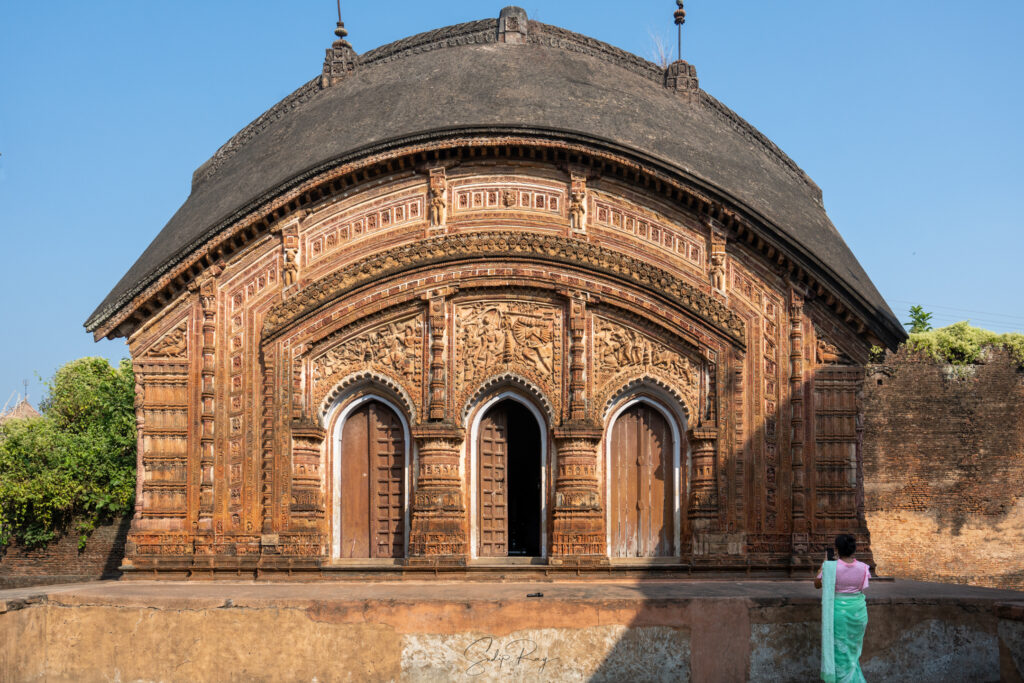
It is interesting to note that, these temples are noteworthy for their architectural styles, which have set them apart from the temple architecture of the rest of India. The temples of Bengal are devoid of grand scale and ornate sculptures – a stark contrast from its Nagara and Dravida counterparts. Curiously enough, Bengal’s temples were built following the model of straw – thatched huts of common people. The carved roofs became a unique feature of Bengal’s temple architecture. Even, in most cases, a temple’s style derived its name from the number of carved roofs. Thus, we come across “do chala” or twin roofed, “char chala” or four roofed, “aatchala” or eight roofed and so on. Later, small towers with conical roofs or “ratna” were added above the carved roofs. The temples were then styled as “pancharatna” (having five small towers), “navaratna” (having nine small towers), so on and so forth.
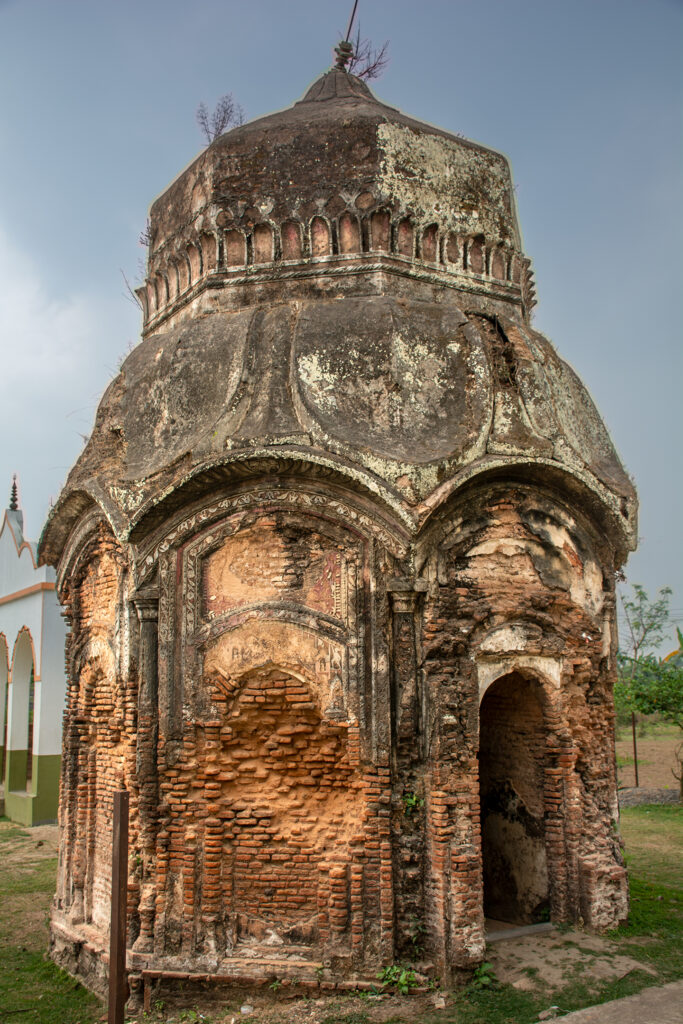
Table of Contents
Where are these terracotta temples located:
The terracotta temples are mostly concentrated in the Baranagar area of Murshidabad. Baranagar is located a few kilometer away from Azimganj. The temples were commissioned by the renowned Rani Bhabani of Natore.

About Rani Bhabani of Natore:
Rani Bhabani of Natore is one of the most enigmatic characters in Bengal’s history. Also known as “Ardhabangeshwari” or “Lady of half of Bengal” and “Natorer Rani” or Queen of Natore, Bhabani was the zamindar of present day Rajshahi in Bangladesh. She succeeded her late husband, Ramakanta Moitra in 1748.

Rani Bhabani was exceptionally intelligent, having a sharp mind and unparalleled business acumen. As a result, she brilliantly managed her inherited zamindari at Rajshahi for over 40 years and even extended her zamindari to Murshidabad, Nadia, Bardhaman, and Birbhum.
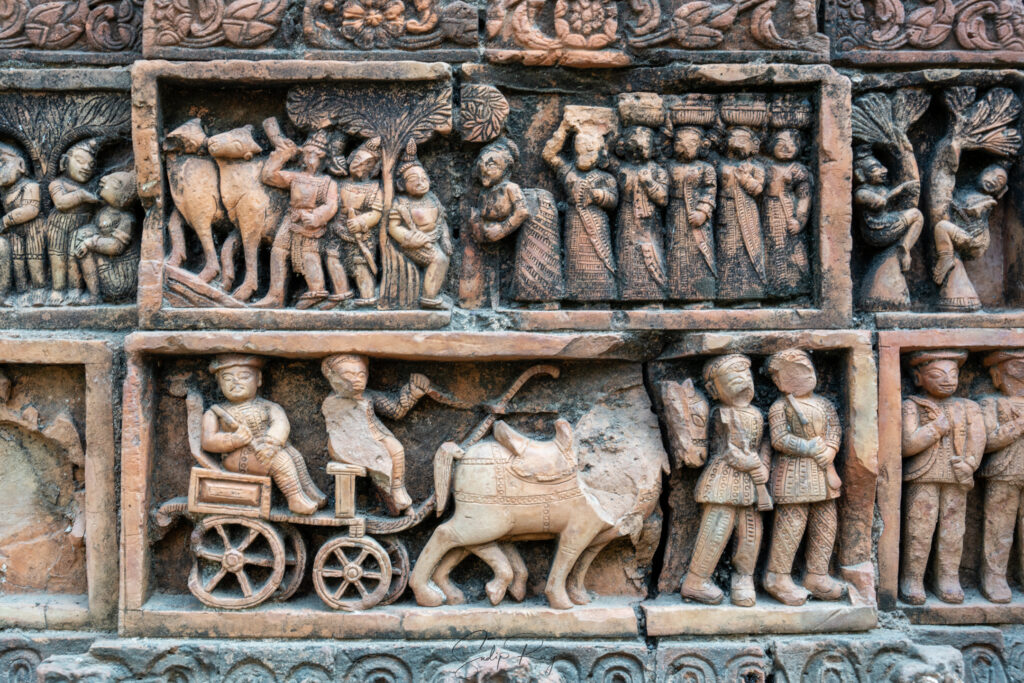
The Rani was also renowned for her philanthropic gestures. She built ponds and tanks for alleviating water crises of her subjects, constructed roads, made generous donations to educational institutes, and also helped countless helpless people during the Great Famine of 1770 by distributing foods and reliefs.

Moreover, Rani Bhabani became famous by erecting a large number of temples both in Bengal and Varanasi. She also undertook renovation works at Tarapith Temple in Birbhum and Bhabanipur Temple in Bogra, Bangladesh.

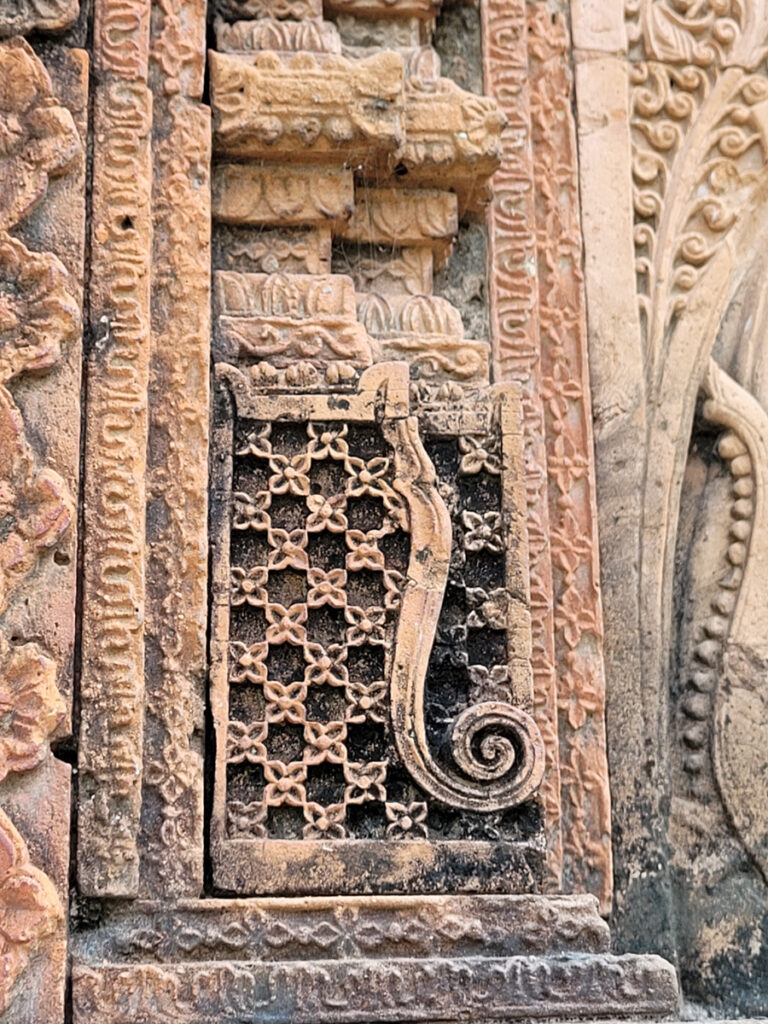
Why Rani Bhabani built terracotta temples in Baranagar:
Rani Bhabani wished to convert the erstwhile Baranagar into second Varanasi. Hence, she embarked aupon her ambitious project of erecting 108 terracotta temples in Baranagar in the 1750s. However, over the time, most of these temples fell prey to the changing course of Bhagirathi river. Only a handful of the Rani’s temples have survived to the present time.
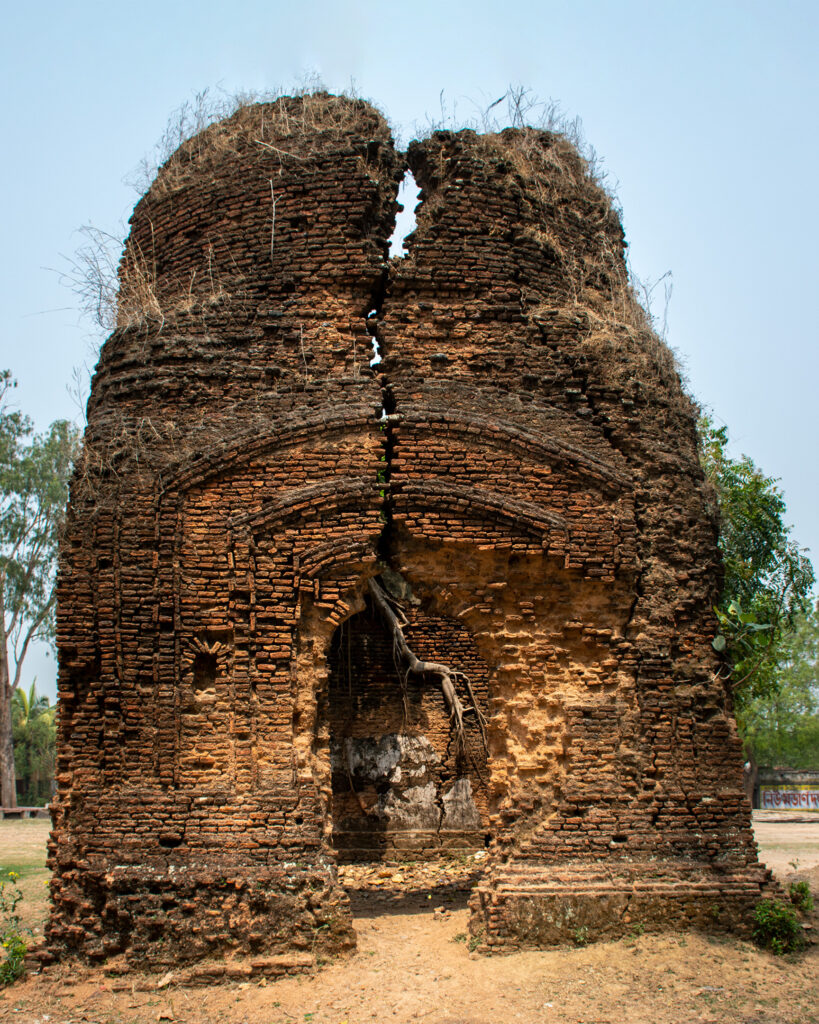
The Terracotta Temples of Baranagar:
The Char Bangla Temple:
Undoubtedly, the most famous among the temples of Baranagar is the Char Bangla Temple. Situated just beside the Bhagirathi, it is a cluster of four Shiva temples. These are built in “do-chala” or two roofed style, which is also referred to as “ek-bangla” temples. Due to the presence of four “ek-bangla” temples together, this cluster is named as Char Bangla.

The four temples, set atop 1.5 feet platforms, are situated in the four cardinal directions. Each have three doors and house one Shiva linga inside.
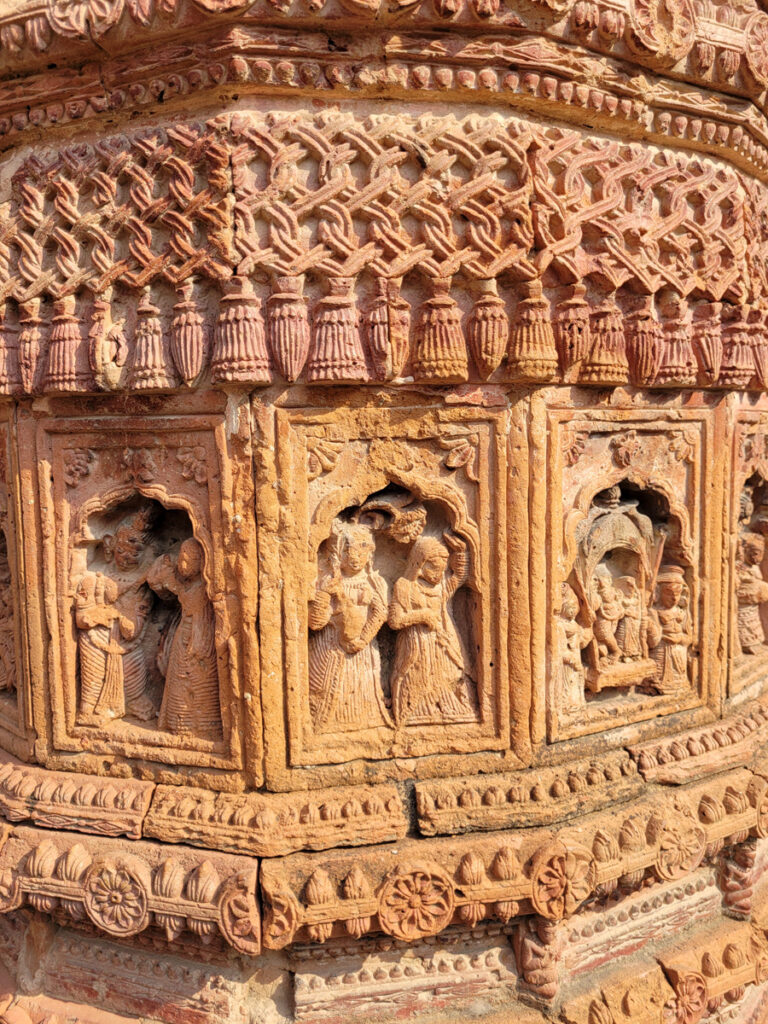
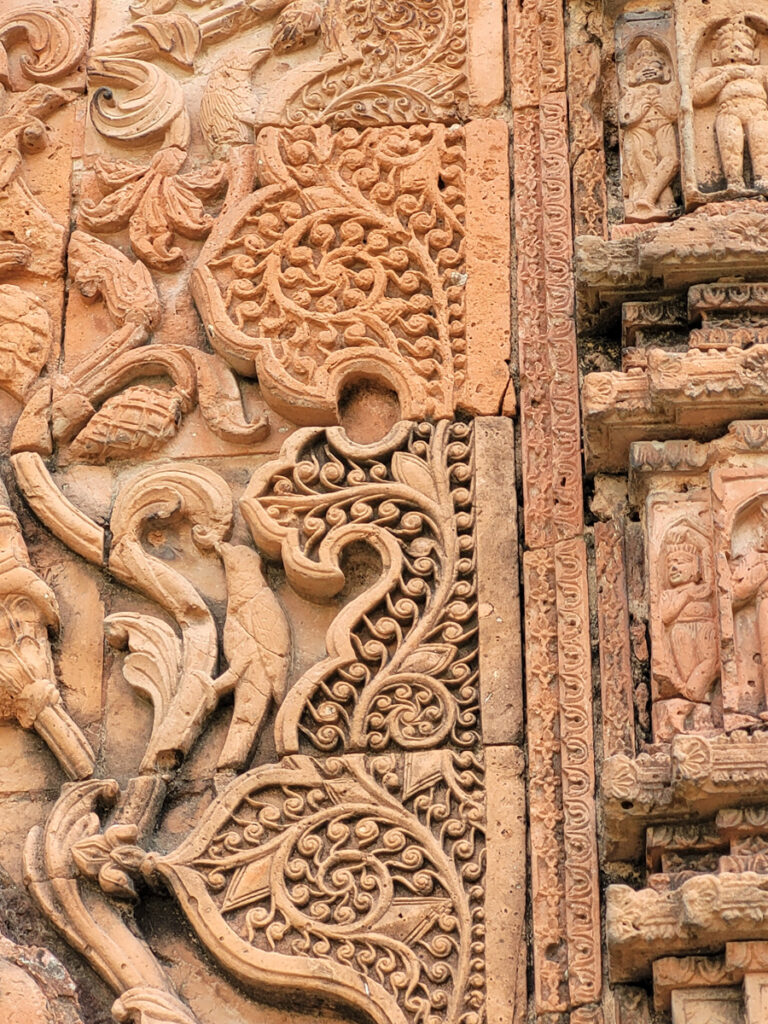
The northern temple is the most ornate one, followed by the western temple. The northern temple has an elaborate carving of Rama and Ravana’s battle above the main entrance. Also, there are exquisite sculptures of Durga, Kali, Shiva accompanied by his companions, Nandi and Bhiringi, as well as scenes from Ramayana and Mahabharata. Further, walls depicts daily lives of common people, soldiers marching for battles, various animals, and floral and leaf motifs.
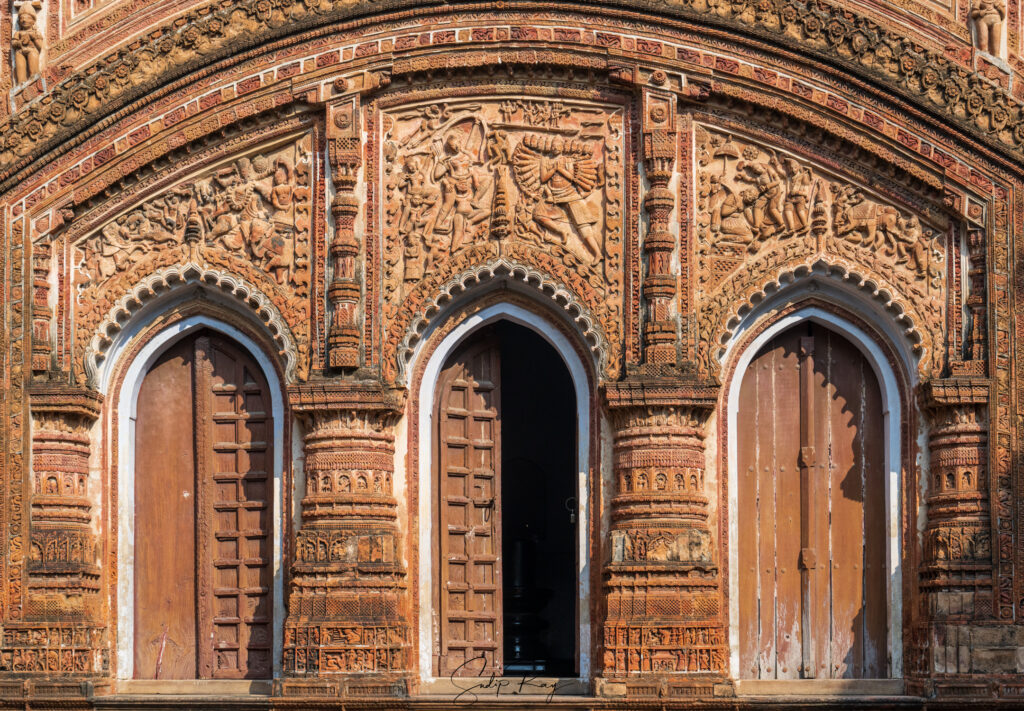

The western temple is also strikingly carved with scenes of Puranas, Bhagvata, Ramayana, and Mahabharata.


The temple on the south has least carvings and looks a bit incomplete when compared with the other three.
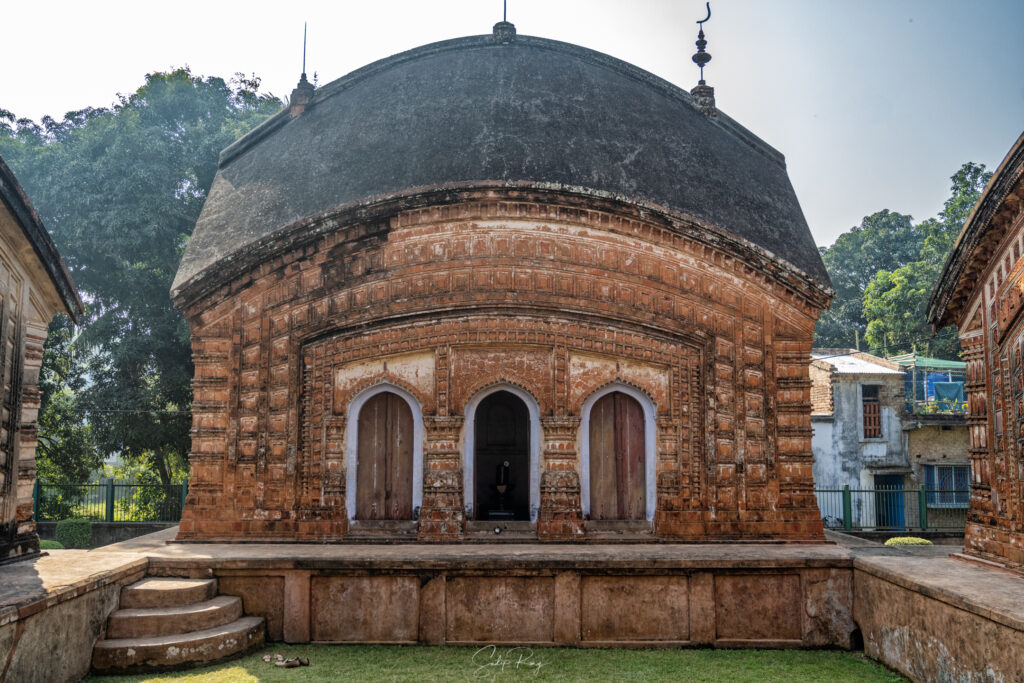
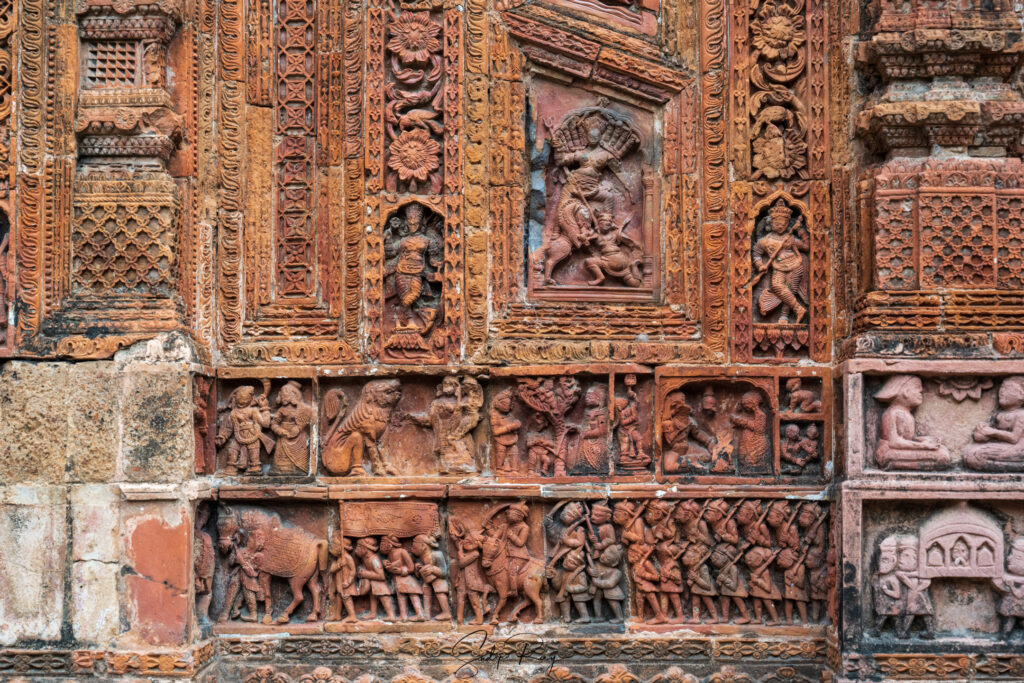
The eastern temple is the unique one, having reliefs made of lime and mortar. It has striking scenes of the battle of Kurukshetra along with sculptures of Radha-Krishna.

Bhabanishwar Temple:
This unique-looking temple was commissioned by Tarasundari Devi, daughter of Rani Bhabani. It was completed in 1755. Dedicated to Shiva, this temple is octagonal in shape with a roof that resembles an inverted lotus. Instead of terracotta panels, it is decorated with detailed carvings of lime and mortar. With arched open gateways in all directions, the temple houses a Shiva linga. Its doors remain closed for the most part of the day. Try visiting around 8 in the morning to get ‘darshan’ as the caretaker cleans the entire temple including the sanctum during this time.
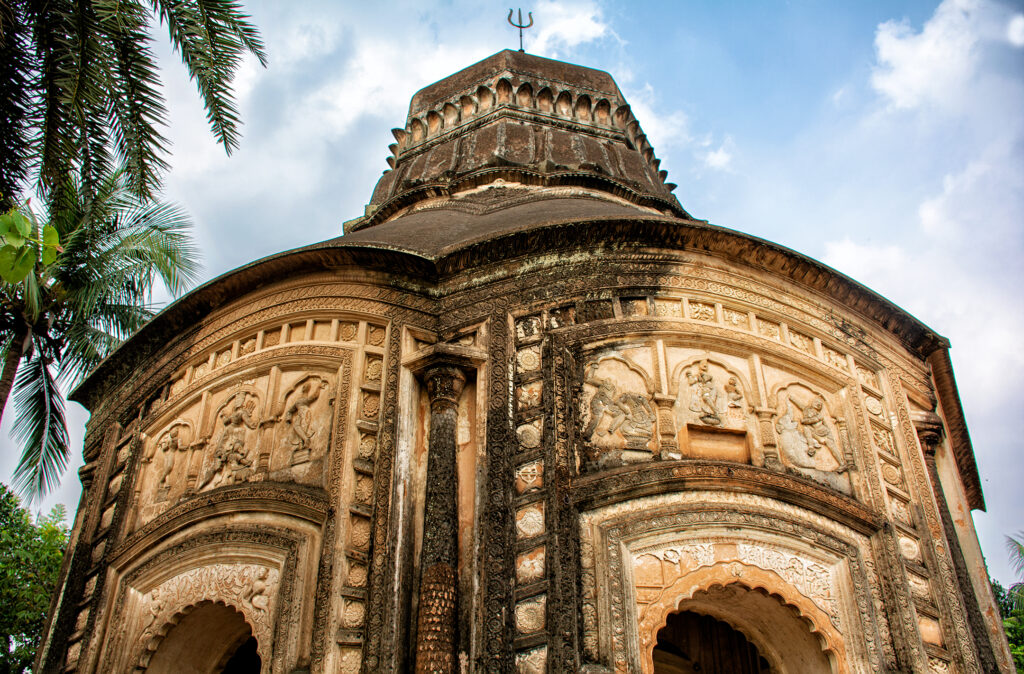
Gangeshwar Temple:
Built in the epic “Jor Bangla” style (which looks like two temples have been built together sharing a common wall), Gangeshwar Temple is another famous terracotta temple of Murshidabad. The terracotta works on its walls are of high quality. Intricate and sophisticated, the terracotta panels here testify to the brilliant skills of Bengal’s artists. Though consecrated to Lord Shiva, the carvings on its walls mostly depicts life and ‘leela’ of Lord Krishna. There are also scenes from Ramayana and Mahabharata, along with elegant floral motifs and scenes from daily lives of common people.
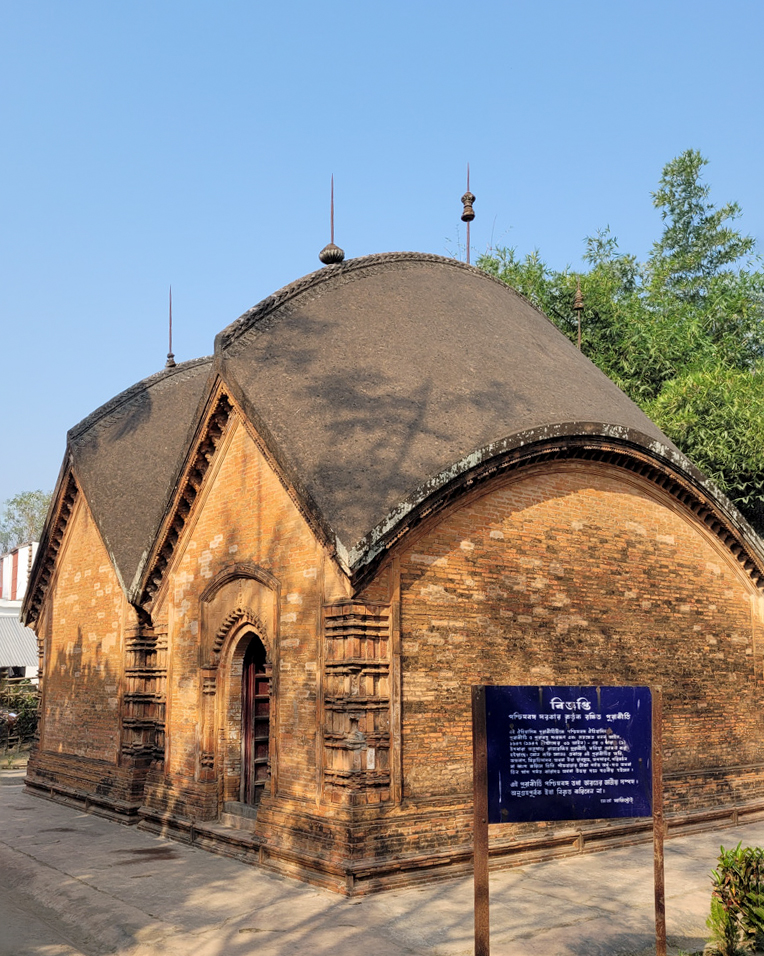
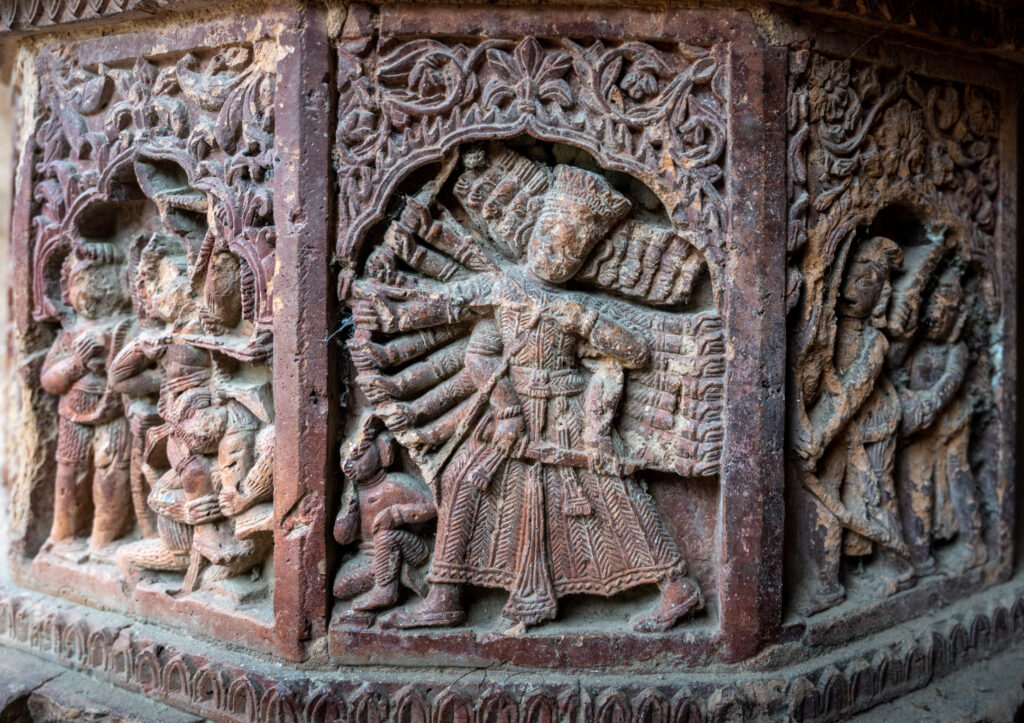
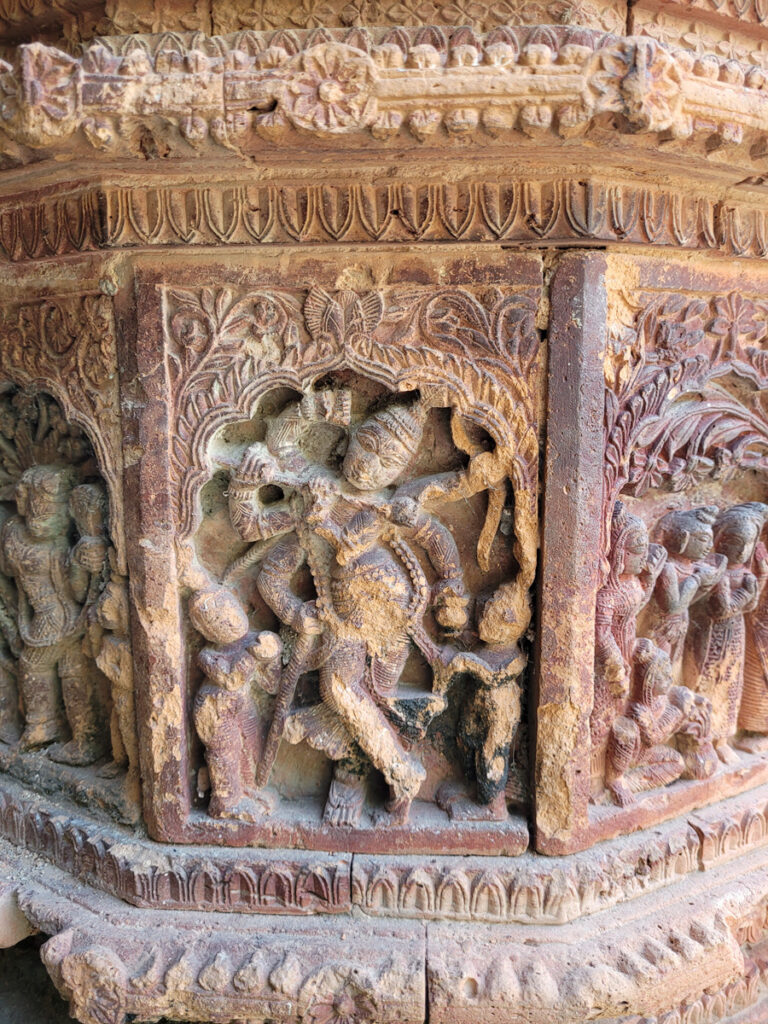

Panchamukhi Shiva Temple:
As the name suggests, this temple houses a Shiva linga with five faces. Built in traditional “do chala” style, it is an active temple. It has been given a fresh coat of red paint, which has sadly concealed the terracotta sculptures on its walls.
Ratneshwar Temple of Bhattabati:
This incredibly beautiful temple lies a tad bit away from Baranagar. It is situated 5 km away from Lalbagh Sadar Ghat. Legend says that, during the reign of Alauddin Hussain Shah, 1200 Bhatta Brahmin families from Carnatic region of South India settled here. Hence, the place was named as Bhattabati or residence of the Bhattas.
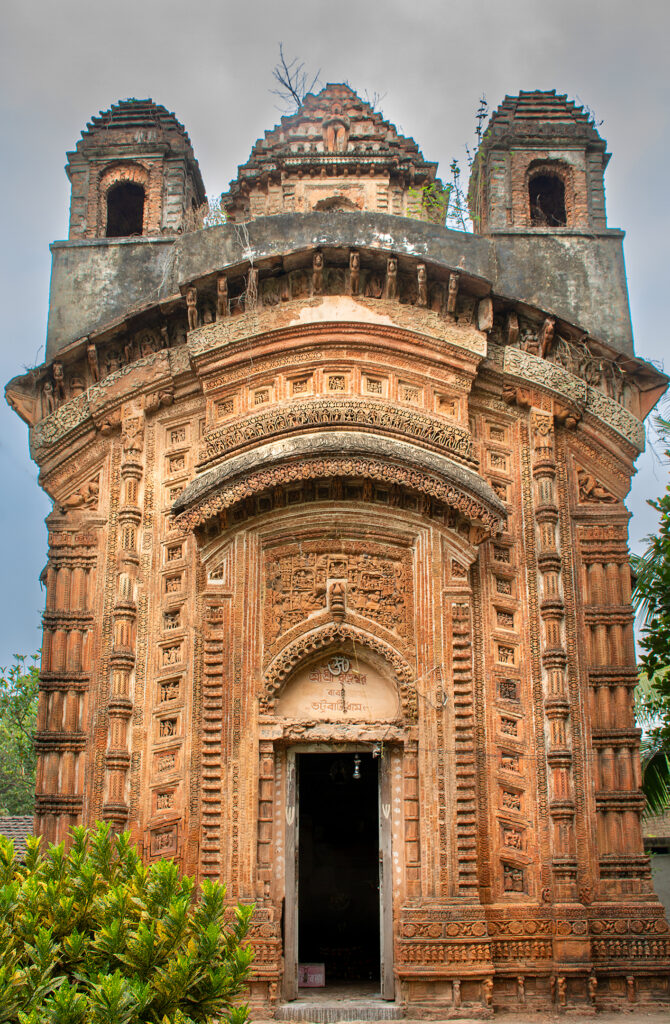
Nothing is known about the founder of this temple. Devoted to Lord Shiva, the Ratneshwar Temple is built in exquisite “Pancha Ratna” style, having five pinnacles on its roofs. The ornate terracotta works are undoubtedly one of the best in entire West Bengal. Some of the most striking terracotta works depict Mahisasuramardini (Goddess Durga slaying Mahisasura and flanked by Ganesha, Lakshmi, Saraswati, and Kartick), Dasavatara of Lord Vishnu, Rash Leela of Lord Krishna, Gour-Nitai, and a massive manifestation of Vamana Avatar. Along with these, you will also find events of Ramayana and Mahabharata, royal court scenes, and floral and geometric motifs.

Sadly, this artistic temple is in sorry state with plants overgrowing its roofs and walls. Without proper initiative, the temple will soon turn into utter ruin.
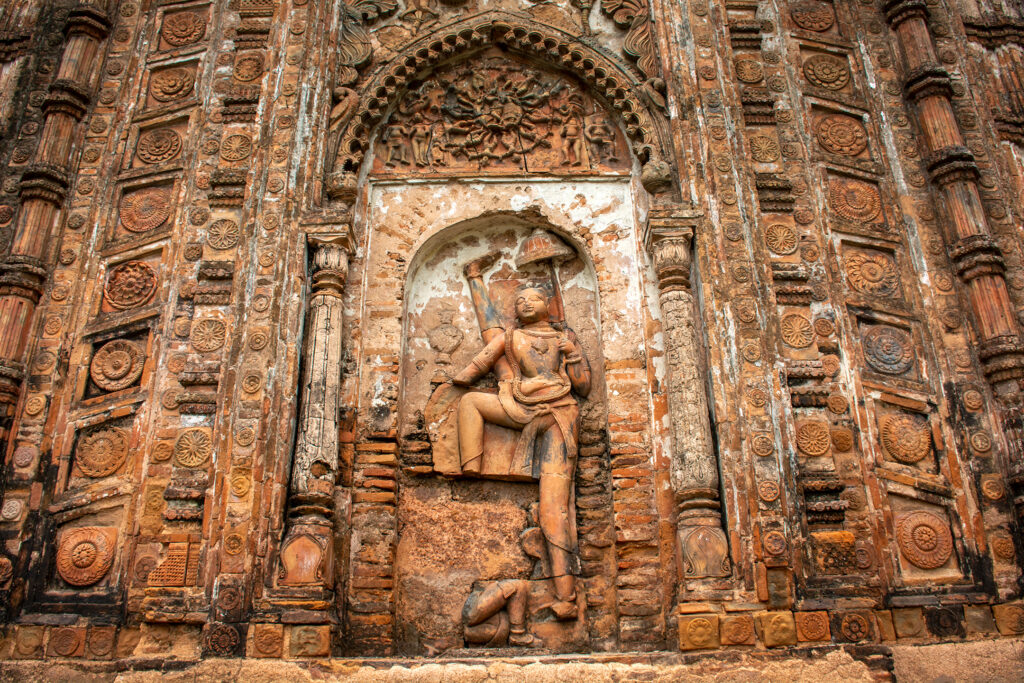
How to reach the terracotta temples of Baranagar:
Baranagar is around 250 km away from Kolkata.
By train: The nearest railway station of Baranagar is Azimgunj Junction. Some of the North Bengal bound trains give stoppage at Azimgunj Junction. We advise opting for Ganadevta Express (departure at 6-05 AM from Howrah and arrival at 12 PM in Azimganj), Intercity Express (departure at 3-20 PM from Howrah and arrival at 7-32 PM in Azimganj), and Teesta Torsha Express (departure at 2-45 PM from Sealdah reaching Azimganj at 6-55 PM). From Azimganj Junction, Bari Kothi is barely 10 minutes away.
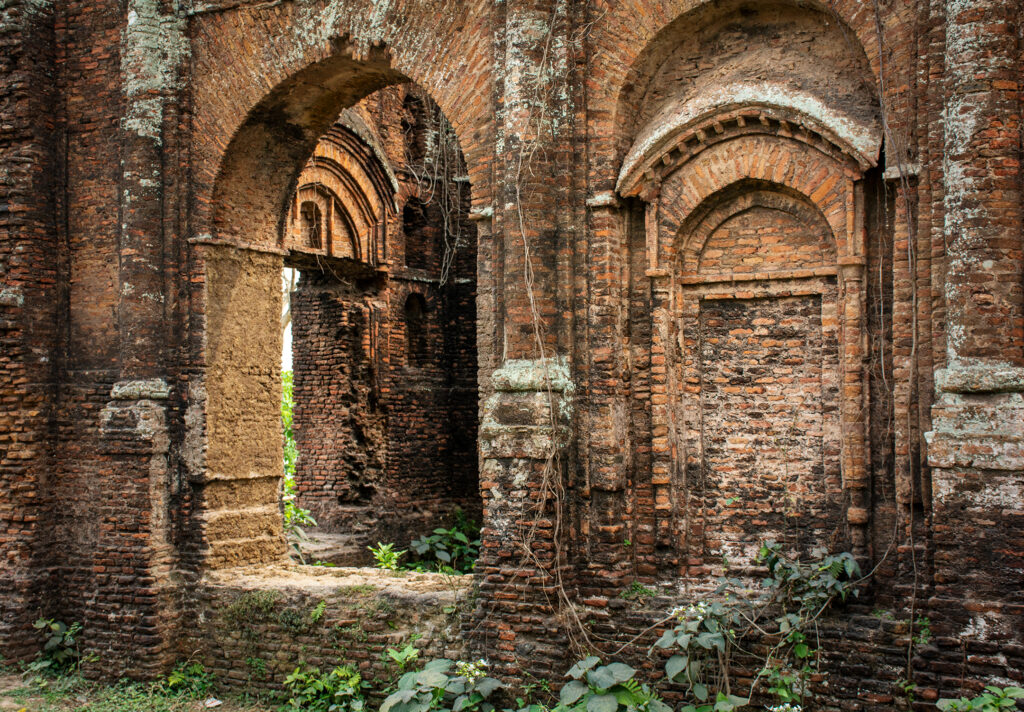
By road: You can also hire a cab to reach Murshidabad. The journey takes little more than 6 hours.
If you are arriving from Jiaganj, take a ferry from Sadar Ghat to cross the Bhagirathi river. Upon reaching the other side, hire an e-rickshaw to visit the temples.
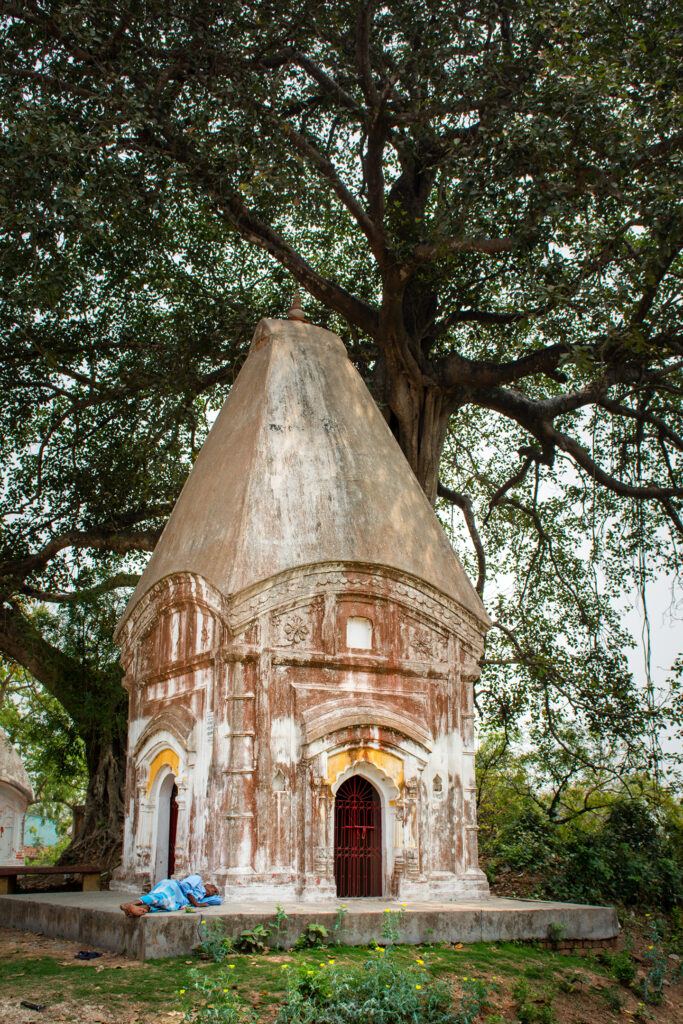
Where to stay in Baranagar:
You won’t find any accommodation in Baranagar itself. You need to stay at Jiaganj or Azimganj, which have lots of options suiting every budget. Some of the good hotels are Jalchhabi Hotel & Resort, Hotel Manjusha, and Hotel Sagnik. If you are up for a luxurious staycation, go for Bari Kothi in Azimgunj. For booking a stay at Bari Kothi, visit here.



